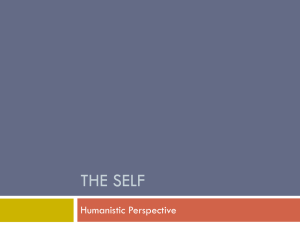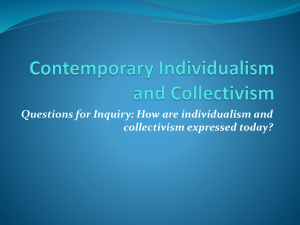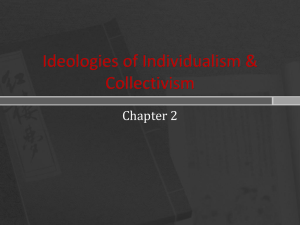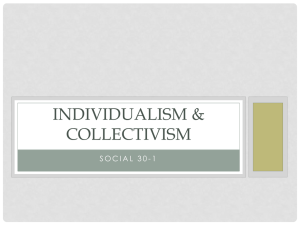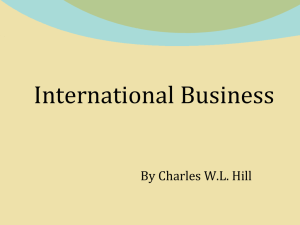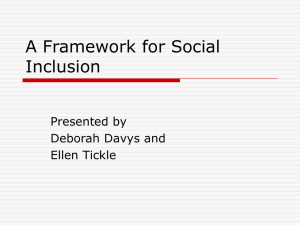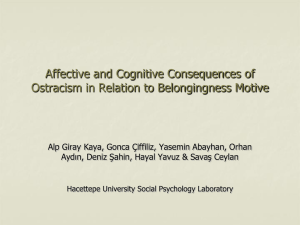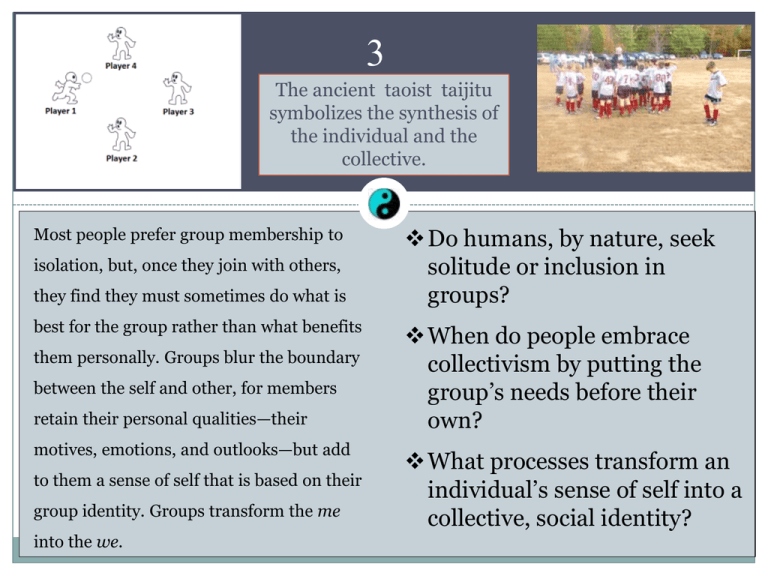
3
The
ancient taoist taijitu
Chapter
3
Inclusion
and
symbolizes the synthesis of
the individual and the
Identity
Inclusion
and Identity
collective.
1
Most people prefer group membership to
isolation, but, once they join with others,
they find they must sometimes do what is
best for the group rather than what benefits
them personally. Groups blur the boundary
between the self and other, for members
retain their personal qualities—their
motives, emotions, and outlooks—but add
to them a sense of self that is based on their
group identity. Groups transform the me
into the we.
Do humans, by nature, seek
solitude or inclusion in
groups?
When do people embrace
collectivism by putting the
group’s needs before their
own?
What processes transform an
individual’s sense of self into a
collective, social identity?
3: Inclusion and Identity
Isolation to
Inclusion
Need to
Belong
Inclusion and
exclusion
Inclusion
and
Human Nature
Individualism to
Collectivism
Micro:
The Social Self
Meso:
The Group
Culture
Macro:
Collectivism
across Cultures
Personal Identity to
Social Identity
Social
Identity
Theory
Motivation
and Social
Identity
Isolation to
Inclusion
All human beings, “have a
pervasive drive to form and
maintain at least a minimum
quantity of lasting, positive,
and impactful interpersonal
relationships.”
Roy Baumeister & Mark Leary (1995, p.
497).
Need to
Belong
Daniel Defoe’s Robinson
Crusoe
I am cast upon a
horrible, desolate
island; void of all hope
of recovery. I am
singled out and
separated, as it were,
from all the world, to be
miserable. I am divided
from mankind, a
solitary; one banished
from human society. I
have no soul to speak to
or to relieve me.
Rubin
Hurricane
Carter:
I had nothing,
absolutely
nothing. I was
trapped at the
bottom, the
lowest point at
which a human
being can exist
without being
dead: solitary
confinement. I
had nothing to
hold on to, no
family, nobody
to do anything
for me.
Isolation can be
rejuvenating, but:
• Isolated individuals (e.g., stranded
explorers) report negative effects
• Solitary confinement recognized
as a severe punishment
• People seek membership in a
variety of groups
• People build their “social capital”
by creating online and face-to-face
relationships
People affiliate
in groups
Putnam’s “bowling alone”
hypothesis: affiliation
patterns are shifting
Type of Loneliness: social and emotional
Different groups reduce different
types of loneliness
Psychological intimacy (emotional loneliness)
10
Lovers
Small family
8
Married couple
Therapy group
Best friends
Space station
crew
6
Support group
Regulars at a bar
Commune
Work team
Sorority
4
Rescue team
A class in college
2
Hobby club
Audience
Crowd
0
0
1
2
3
4
5
6
7
Integrated involvement (social)
8
9
10
Inclusion and
exclusion
The Inclusion/Exclusion Continuum
Rejection
Acceptance
Maximum
Active
Passive
Exclusion
Exclusion
Exclusion
Group rejects Group avoids
or ostracizes
person
person
Group
ignores
person
Ambivalence
Group neither
accepts nor
rejects
individual
Passive
Active
Maximum
Inclusion
Inclusion
Inclusion
Group
allows
member to
join
Group
welcomes
member
Group
actively
recruits
member
Inclusion and
exclusion
Ostracism: Excluding
one or more individuals
from a group by reducing
or eliminating contact
with the person, usually
by ignoring, shunning, or
explicitly banishing them.
Researchers have studied reactions
to ostracism in various ways,
including
• The “life alone” paradigm
• The ball-toss paradigm (and
cyberball)
• The exclusion paradigm
The Temporal Need-Threat Model of Ostracism: Williams, 2009
Reactions to Exclusion
Fight vs Flight
Tend and Befriend
Withdrawal and freezing
Attention to social cues
Aggressive, combative
Increased motivation
orientation
Prosocial orientation
Results from Gaertner, Iuzzini, & O’Mara, 2008
Inclusion and
Survival
• The evolution of
gregariousness (the “herd
instinct”)
• Leary’s sociometer theory
• Neurological reactions to
exclusion
The Evolution of Gregariousness
Leary’s sociometer theory: self-esteem warns of
possible exclusion
Mark Leary:
We need to
think about
ourselves
occasionally,
but none of
us needs to
think about
ourselves as
much as we
do.
Self-esteem is not the evaluation of
your worth—it is an indicator of how
well you are accepted into social
groups
The Biology of Ostracism and Inclusion
dACC
(dorsal cingulate cortex)
Anterior insula
Ostracism triggers “pain”
areas of the brain
Isolation to
Inclusion
Individualism to
Collectivism
Individualism to
Collectivism
Personal Identity to
Social Identity
Individualism
Collectivism
A tradition,
ideology, or
personal outlook
that emphasizes
the primacy of the
individual and his
or her rights,
independence, and
relationships with
other
A tradition,
ideology, or
personal
orientation that
emphasizes the
primacy of the
group or
community rather
than each
individual person.
Individualism to
Collectivism
Individualism to
Collectivism
Individualism
Collectivism
A tradition,
ideology, or
personal outlook
that emphasizes
the primacy of the
individual and his
or her rights,
independence, and
relationships with
other
A tradition,
ideology, or
personal
orientation that
emphasizes the
primacy of the
group or
community rather
than each
individual person.
Collectivism
Individualism
The individual is primary, first. His
or her rights must be recognized and
put above the right of the group as a
whole. If the group’s goals aren’t
compatible with the individual’s goals,
then the individual is free to go his
or her own way.
Copyright 2004 by Donelson R. Forsyth
The group is primary,
first. Its rights must be
recognized and
put above the right of the
individual. The individual
belongs to the group.
Individualism to
Collectivism
Micro:
The Social Self
Individualists
Collectivists
Micro:
The Social Self
Differences
• individualists
and collectivists
America is woven of many strands. I
would recognize them and let it so
remain. Our fate is to become one,
and yet many.
― Ralph Ellison, Invisible Man
• sex differences
• generational
differences
• Brewer’s optimal
distinctiveness
theory
“
Meso:
The Group
Culture
Individualism
Collectivism
Autonomy and
uniqueness
Conformity and duty
Exchange relations
Communal relations
Equity
Equality or need
Egocentric
Reciprocity
Sociocentric
Ingroup oriented
The mean distributions in the Ultimatum Game from people living in 16
different indigenous societies and cultures around the world.
Macro:
Collectivism
across Cultures
Cultures: East vs.
West
Subcultures: Some
ethnic groups, such
as Asian Americans
and Latinos, are
more collectivistic
than individualistic
Regions of the U.S.:
Culture of Honor in
the south
Source: Cohen, Nibsett, Bowdle, & Schwartz
Isolation to
Inclusion
Individualism to
Collectivism
Individualism to
Collectivism
Personal Identity to
Social Identity
Individualism
Collectivism
A tradition,
ideology, or
personal outlook
that emphasizes
the primacy of the
individual and his
or her rights,
independence, and
relationships with
other
A tradition,
ideology, or
personal
orientation that
emphasizes the
primacy of the
group or
community rather
than each
individual person.
Personal Identity to
Social Identity
Social Identity Theory:
Basics
• Basic assumption: the selfconcept is determined by group
memberships
• Personal identity (individual
self) and Social identity
(collective self)
• Tajfel & Turner’s minimal
intergroup situation
• Key processes: categorization
and identification
Social Identity Theory
Social categorization:
Individuals automatically
classify people, including
themselves, into groups.
Social identification:
accepting as selfdescriptive (selfstereotyping) the qualities
attributed to one’s group
(depersonalization)
Categorize
I am a member
of group X
I have qualities
A, B, and C
People in group
X have qualities
A, B, and C
Collective Self-esteem
Self-esteem depends on an individual’s personal qualities
and the value of the groups to which they belong
Motivation and Social
Identity
Ingroup-outgroup bias: Rating one’s own group more positively
than other groups.
Basking in Reflected Glory (BIRG): stressing association with
successful groups.
Social creativity: Restricting comparisons between the ingroup
and other groups to stress the ingroup’s relative strengths
Stereotype threat: Anxiety-provoking (and self-confirming)
belief that others’ are biased against one’s group
Social mobility: Leaving the group
Social Identity Theory
Inclusion
Personal
Identity
Achievements
Need for selfesteem
Group
achievements
Social Identity
Increased
self-esteem
Group
favoritism
Outgroup
rejection
Not clear if outgroup rejection raises self-esteem
Review
Isolation to
Inclusion
Need to
Belong
Inclusion and
exclusion
Inclusion
and
Human Nature
Who are you? A complex, hard-to-answer, question.
Individualism to
Collectivism
Micro:
The Social Self
Meso:
The Group
Culture
Macro:
Collectivism
across Cultures
Personal Identity to
Social Identity
Social
Identity
Theory
Motivation
and Social
Identity

